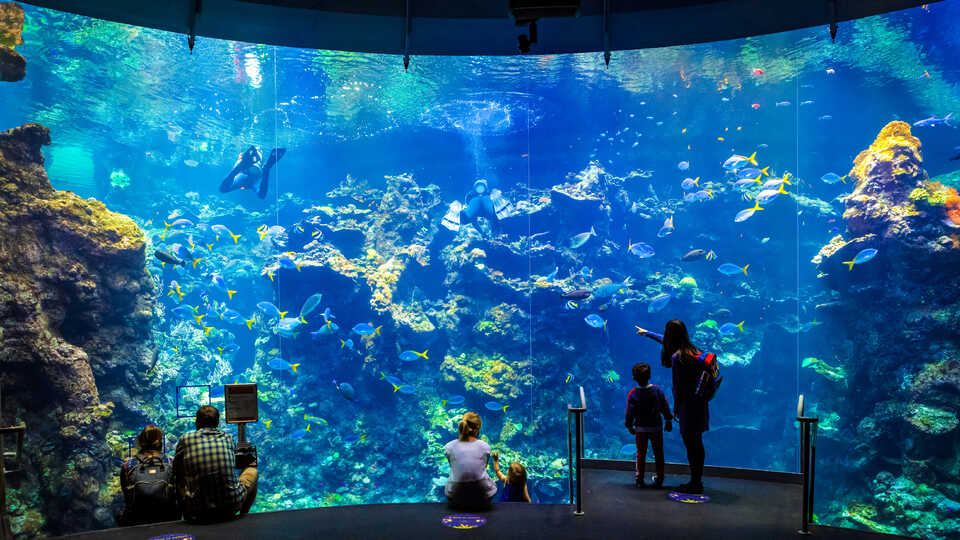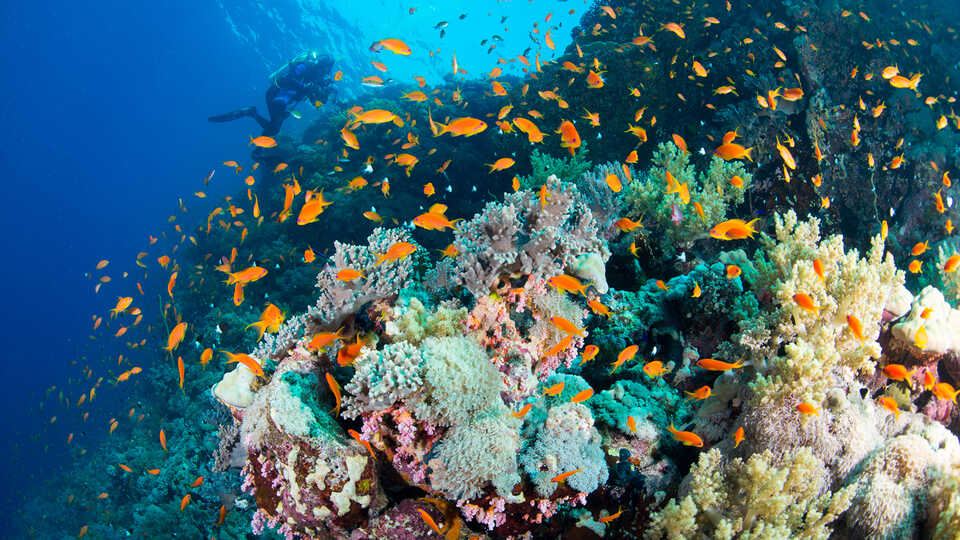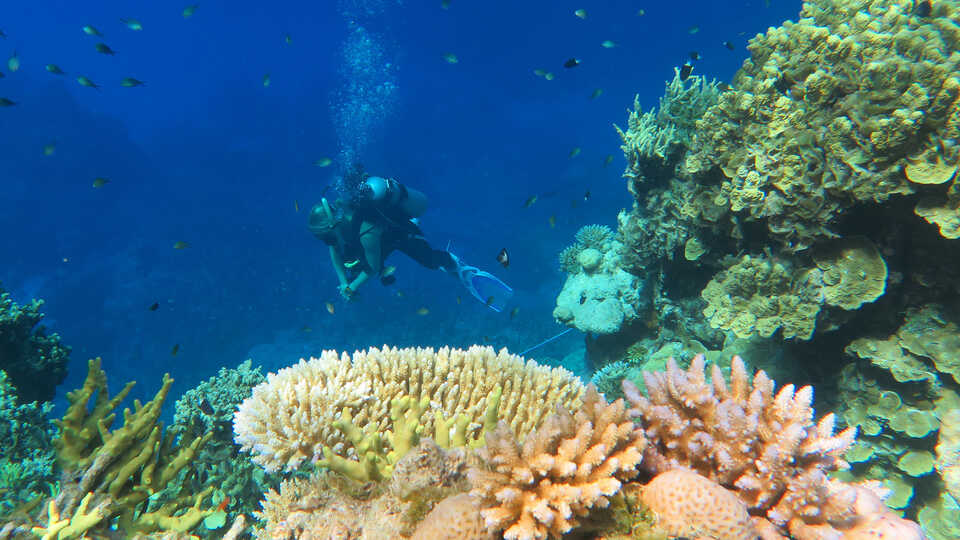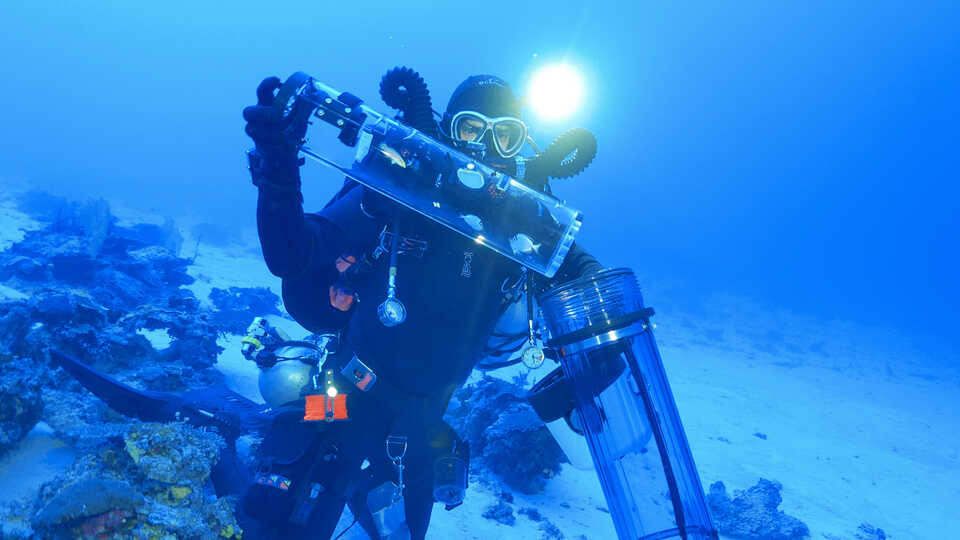
Make friends with anemones as you explore an array of coral-reef-themed activities created for kids ages 8-11.
Known as the “rainforests of the sea,” coral reefs are like bustling underwater cities bursting with life. Learn more about why these vibrant ecosystems are critically important to all life on Earth through guided videos, crafts, interactive programs, and live webcams.
Please note: While Science @ Home activities are designed to be conducted by kids, some little ones might need adult help with reading instructions and preparing crafts.

Day 1: All about coral reefs
Immerse yourself in an overview of coral reef science to learn how these complex, colorful ecosystems work. (45-60 minutes)
Photo: Luiz Rocha © California Academy of Sciences
Hear from Academy educator Dave on the basics of coral reef biology, and where in the world they can be found—including at the Academy! (14 minutes)
The Academy is home to the largest living indoor coral reef on Earth—and it’s Steinhart Aquarium Director Bart Shepherd’s pride and joy. (1 minute)
While you watch this video, think about the two questions below. Share your answers with a friend, or family member, or just think in your head.
- Why is the coral reef exhibit Bart’s favorite at the Academy?
- What are some things Bart and the team needed to do to plan and build a coral reef exhibit at the Academy?
How do species interact on a coral reef? Dive beneath the ocean waves and explore the many unique symbiotic relationships found in this diverse ecosystem. (5 minutes)
While munching on real reefs is not recommended, it’s an absolute must when you make your own edible “coral polyps.”

Day 2: Building reefs
Coral reefs are marvels of animal engineering. Meet the tiny creatures behind these impressive structures. (45 minutes)
Enjoy front-row seats to all the action inside the Academy’s 212,000 gallon Philippine Coral Reef exhibit.
While you watch this video, think about the three questions below. Share your answers with a friend or family member or just think in your head.
- What do you see inside the coral reef exhibit? Are there animals? What kind?
- What do you see the animals doing?
- What do you think the human animals are doing in the tank, if you see any?
Take a tour of a tiny coral polyp to learn how they transform seawater and algae into the raw materials that make up a reef. (3 minutes)
While you watch this video, think about the four questions below. Share your answers with a friend or family member or just think in your head.
- What do corals use to build their skeletons?
- What do the corals do over and over again to build an entire reef?
- How long might it take to build a reef?
- How might the ocean impact the shape of the coral?
Zoom into an incredible three-dimensional scan of a coral specimen, part of the Academy’s natural history collections. As you investigate the coral from all angles, consider the three questions below:
- What do you notice about the coral?
- Does its shape remind you of anything?
- Read the information below the specimen. Can you figure out where it was collected?
Can’t create calcium carbonate from seawater? No worries! Build your dream reef with Play-Doh or clay instead.

Day 3: Healthy coral reefs
Coral reefs are fabulous—and fragile. Learn more about the threats facing this delicate ecosystem. (45 minutes)
Photo: Luiz Rocha © California Academy of Sciences
Plunge into a teeming, tropical Philippine coral reef and get a closer look at the eels, crabs, sea stars, and nudibranchs that call it home. (3 minutes)
While you watch this video, think about the three questions below. Share your answers with a friend or family member or just think in your head.
- What are some of the animals you see living on this coral reef in the Philippines?
- Have you ever been to a dentist? How do eels visit a dentist?
- What are some of the things animals eat on the coral reef? Are they different from what you eat?
We’re all connected to coral reefs, even if we’re thousands of miles away. Learn more about how our actions impact reefs, and why the time is now to protect them. (6 minutes)
While you watch this video, think about the four questions below. Share your answers with a friend or family member or just think in your head.
- How do carbon dioxide and other fossil fuels hurt coral reefs?
- Why do you think it is important to help protect coral reefs?
- What are some ways the Academy is helping to protect coral reefs?
- What are things you can do to help save coral reefs?
Ocean acidification is one of the biggest threats to coral reefs. With a few household ingredients, you can see how it works—right in your own kitchen.
Plus, watch this video of Academy educator Aya sharing all the dirty details about ocean acidification—and how humans can be part of the solution.
It’s Baby Blacktip Reef Shark’s first day exploring the coral reef. What will he discover?

Day 4: Be a coral reef diver
Academy scientists travel all over the world to learn more about coral reefs—and how to save them. Join them on their aquatic adventures. (45 minutes)
Exploring the “Twilight Zone” 200-500 feet below the surface is not for the average diver. Learn more about the unique creatures that live at these depths, and the challenges Academy scientists have had to overcome to discover them. (2 minutes)
While you watch this video, think about the two questions below. Share your answers with a friend or family member or just think in your head.
- What makes Twilight Zone reefs different from shallow reefs?
- What are some of the animals that live in these deep reefs?
Step inside the Academy’s dive locker and see what it takes to keep everything running swimmingly. (10 minutes)
While you watch this video, think about the three questions below. Share your answers with a friend or family member or just think in your head.
- Divers at the Academy use a lot of special equipment. What equipment did you see during Dave’s tour of the dive locker?
- What equipment did you see as Dave got ready to dive?
- Have you ever been diving? Have you ever used special equipment?
Maintaining neutral buoyancy is an important skill that every Twilight Zone diver must master. Get a head start with this at-home experiment.
Watch as Academy educator Louise demonstrates the “diver in a bottle” experiment using a plastic bottle and an eyedropper. (5 minutes)

Kid & caregiver extension activities
Ready for more reef resources? You’ve swum to the right place.
Hear from an Academy ichthyologist and coral biologist about why diving the Twilight Zone is so exciting—and important. (3 minutes)
Coral reefs are not just beautiful and biodiverse—they’re incredibly important for humans, too. (4 minutes)
While you watch this video, think about the question below. Share your answers with a friend or family member or just think in your head.
- In what ways do people depend on coral reefs?
In this article, learn more about Senior Director of Steinhart Aquarium Bart Shepherd’s journey to becoming a scientist, the Academy’s role in researching the ocean, and challenges facing coral reefs today.
Learn more about the amazing scientific research being conducted by Academy scientists and partners through our Hope for Reefs initiative.
Enjoy an eclectic array of science content for all ages, from distance learning resources to in-depth livestreams.